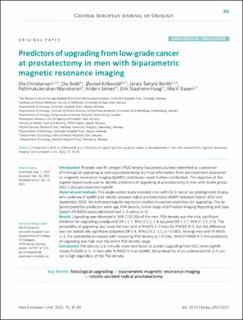| dc.contributor.author | Christiansen, Ola | |
| dc.contributor.author | Bratt, Ola | |
| dc.contributor.author | Kirkevold, Øyvind | |
| dc.contributor.author | Saltyte Benth, Jurate | |
| dc.contributor.author | Manoharan, Pathmakulendran | |
| dc.contributor.author | Selnes, Anders | |
| dc.contributor.author | Haug, Erik Skaaheim | |
| dc.contributor.author | Jordhøy, Marit Slaaen | |
| dc.date.accessioned | 2023-05-09T12:13:44Z | |
| dc.date.available | 2023-05-09T12:13:44Z | |
| dc.date.created | 2022-04-28T11:58:38Z | |
| dc.date.issued | 2022 | |
| dc.identifier.citation | Central European Journal of Urology. 2022, 75 (1), 35-40. | en_US |
| dc.identifier.issn | 2080-4806 | |
| dc.identifier.uri | https://hdl.handle.net/11250/3067300 | |
| dc.description.abstract | Introduction: Prostate-specific antigen (PSA) density has previously been identified as a predictor of histological upgrading at radical prostatectomy, but how information from pre-treatment biparametric magnetic resonance imaging (bpMRI) contributes needs further clarification. The objective of this register-based study was to identify predictors of upgrading at prostatectomy in men with Grade group (GG) 1 and pre-treatment bpMRI. Material and methods: This single-center study included men with GG 1 cancer on prediagnostic biopsy, who underwent bpMRI and robotic-assisted radical prostatectomy (RARP) between March 2014 and September 2019. We estimated logistic regression models to explore predictors for upgrading. The explored potential predictors were age, PSA density, tumor stage and Prostate Imaging Reporting and Data System (PI-RADS) score (dichotomised 1-3 versus 4-5). Results: Upgrading was observed in 56% (73/130) of the men. PSA density was the only significant predictor for upgrading (unadjusted OR = 1.7, 95% CI 1.2; 2.4 adjusted OR = 1.7, 95% CI 1.2; 2.5). The probability of upgrading was lower for men with a PIRADS 1-3 than for PIRADS 4-5, but the difference was not statistically significant (adjusted OR 0.4, 95% CI 0.2; 1.1, p = 0.082). Among men with PI-RADS 1-3, the probability increased with increasing PSA density (p = 0.036). With PI-RADS 4-5 the probability of upgrading was high over the entire PSA density range. Conclusions: PSA density is a clinically important factor to predict upgrading from GG1 when bpMRI shows PI-RADS 1-3. In men with PI-RADS 4-5 on bpMRI, the probability of an undetected GG 2-5 cancer is high regardless of the PSA density. | en_US |
| dc.language.iso | eng | en_US |
| dc.publisher | Polish Urological Association | en_US |
| dc.relation.uri | http://ceju.online/journal/2021/histological-upgrading-biparametric-magnetic-resonance-imaging-2188.php | |
| dc.rights | Navngivelse-Ikkekommersiell-DelPåSammeVilkår 4.0 Internasjonal | * |
| dc.rights.uri | http://creativecommons.org/licenses/by-nc-sa/4.0/deed.no | * |
| dc.subject | biparametric magnetic resonance imaging; | en_US |
| dc.subject | histological upgrading; | en_US |
| dc.subject | robotic-assisted radical prostatectomy. | en_US |
| dc.title | Predictors of upgrading from low-grade cancer at prostatectomy in men with biparametric magnetic resonance imaging | en_US |
| dc.title.alternative | Predictors of upgrading from low-grade cancer at prostatectomy in men with biparametric magnetic resonance imaging | en_US |
| dc.type | Peer reviewed | en_US |
| dc.type | Journal article | en_US |
| dc.description.version | publishedVersion | en_US |
| dc.rights.holder | Copyright by Polish Urological Association. This is an Open Access article distributed under the terms of the Creative Commons Attribution-NonCommercial-ShareAlike 4.0 International (CC BY-NC-SA 4.0) License, allowing third parties to copy and redistribute the material in any medium or format and to remix, transform, and build upon the material, provided the original work is properly cited and states its license. | en_US |
| dc.source.pagenumber | 35-40 | en_US |
| dc.source.volume | 75 | en_US |
| dc.source.journal | Central European Journal of Urology | en_US |
| dc.source.issue | 1 | en_US |
| dc.identifier.doi | 10.5173/ceju.2021.0217 | |
| dc.identifier.cristin | 2019772 | |
| cristin.ispublished | true | |
| cristin.fulltext | original | |
| cristin.qualitycode | 1 | |

